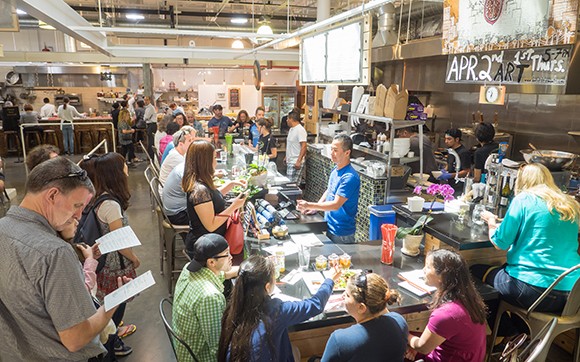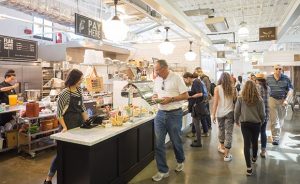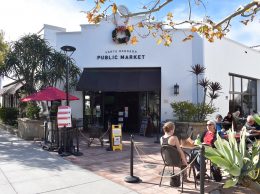Public market project celebrates one year
IN THIS ARTICLE
- Latest news Topic
- Elijah Brumback Author
By Elijah Brumback Friday, April 3rd, 2015

Jerry Lee, owner of Empty Bowl Gourmet Noodle Bar, runs the cash register as customers shop at the Santa Barbara Public Market. (Nik Blaskovich / Business Times photo)
On a recent Monday afternoon, the Santa Barbara Public Market is livelier than some early critics of the concept could have imagined.
There is no room at the bar-style seating at Empty Bowl Gourmet Noodle Bar, The Pasta Shoppe and Santa Monica Seafood as a late lunch crowd chows down on authentic Thai food, freshly-made pasta and raw oysters from Morro Bay. Even though some of the patrons could be accounted for due to spring break, many merchants said the day’s traffic was typical.
People filled most of the tables scattered around the market and the outside seating was taken up by a few college students and some international students from the nearby English language school. Tourists of various ages, who’ve inexplicably managed to find their way off State Street, intermittently gathered at the front of the building. Often, one in the group raised an index finger to direct the party’s gaze toward the simple signage on the building’s Victoria Street side. The shuffling inside the city’s determined atelier of artisanal goods was constant, but tapered to just a handful of shoppers as the afternoon wore on.
The daily crowds are encouraging to the retailers that signed on as tenants nearly one year ago. On April 4 the market is hosting a Spring Fling anniversary party to celebrate that success.
While the market opened to a swarm of intrigued locals and visitors roughly one year ago, the fanfare quickly trickled away as patrons’ expectations weren’t realized and others recoiled from sticker shock. After a few months, the public market experiment had some of the new tenants praying to the gods, hoping they’d make payroll, and others admit it’s still tough today. Still, all the businesses that opened with the market continue to grind it out and some are thriving.
“For the market, this year has been ‘The Little Engine That Could’ kind of story,” said Rori Trovato, owner of Rori’s Artisanal Creamery, which has 150 square feet in the market. “It definitely started out with a bang and fizzled way down. It felt like Santa Barbarans didn’t get it in the beginning, and all of a sudden there were no people.”
Trovato said she heard criticism ranging from “too expensive” to “there’s no parking” — even though there’s free underground parking available, she added.
“Initially I was like, ‘Oh my gosh what have I gotten myself into,’ but eventually the traffic started growing back week by week,” she said. “But there’s still some tweaking to be done.”

Customers line up at Flagstone Pantry. (Nik Blaskovich / Business Times photo)
Marge Cafarelli, the project’s developer, said before the market opened, it would be “swarming” with people and pointed to a number of adjacent developments, including the Crudo Bar from Olio e Limone’s, Arlington Tavern’s and Bouchon’s expanded and new patios as well as the remodeled Victoria Theater that would provide “synergy”.
Since then Cafarelli has reined in her own expectations, but remains a stout champion of the concept, noting that the market is the first of its kind for the city and is just starting to hit its stride.
“It was kind of a shock for Santa Barbara,” she said. “But we stayed patient and I think the community is really adopting and supporting what we do. Business month-over-month is getting better.”
The goal of the market as a collective, she said, is to provide residents and visitors with products and services they want. To find that sweet spot, the market needed some repositioning and those efforts are ongoing.
“What you thought might work initially, sometimes doesn’t and the customers might tell you they want something different and you have to move with that,” she said. “If you’re not doing that, people aren’t going to come back.”
Going forward, Cafarelli said she wants to see the market become a beloved neighborhood grocery and a destination for unique and high-quality products, but with price points that make it accessible to everyone.
In hitting the one-year mark, Cafarelli said “I have to give all the credit to the tenants who have worked so hard. I cannot underscore and emphasize the amount of energy they’ve put into their businesses. It’s really a labor of love.”
Entrepreneurs like Kristen Desmond, head chef and owner of Flagstone Pantry, agreed with that sentiment. The purveyor of natural prepared foods often puts in 80-plus hours of sweat equity a week to make sure her fledgling business is operating the way it needs to so it can support her 10 employees.
“I was really excited as an independent woman-owned business to get in here,” Desmond said. “This is my one and only retail location and the first I’ve owned and operated. It takes a village, though, and I’m not doing this on my own.”
Thanks to her staff and collaboration with other merchants in the market, Desmond said that being in the market has helped her business get exposure.
“The traffic the other merchants draw and that the classes draw — it’s an opportunity for us to get those people to see and sample our offerings,” she said. “It’s a different kind of exposure that I wouldn’t have as a standalone store on State Street … we’re more interesting as a collective than we might be as independents.”
The public market development, which includes the 37-room luxury condo complex Alma del Pueblo, could have been successful without the residential element, according to Cafarelli, though she declined to disclose a revenue figure. The pro-forma for the development is working and that eight-year project has good timing, she said.
Cafarelli purchased what was the old Vons grocery store in 2008 and eventually broke ground in June of 2012 on the development.
“We have five [residential] units in escrow now and I feel very lucky,” she said. “If I were coming out of the ground right now, I’d be very nervous about the shape of the real estate market.”
There are still two 3,900-square-foot storefronts on Victoria Street that have yet to be leased, but Cafarelli told the Business Times she is in talks with several retailers for the space.
“We’re being very picky about that space,” she said. “We want to make sure whoever goes in there is the right fit.”










